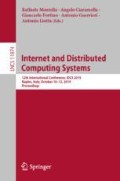Abstract
In typical Wireless Sensor Networks (WSNs), all sensor data is routed to a more powerful computing entity. In the case of environmental monitoring, this enables data prediction and event detection. When the size of the network increases, processing all the input data outside the network will create a bottleneck at the gateway device. This creates delays and increases the energy consumption of the network. To solve this issue, we propose using Hebbian learning to pre-process the data in the wireless network. This method allows to reduce the dimension of the sensor data, without loosing spatial and temporal correlation. Furthermore, bottlenecks are avoided. By using a recurrent neural network to predict sensor data, we show that pre-processing the data in the network with Hebbian units reduces the computation time and increases the energy efficiency of the network without compromising learning.
Access this chapter
Tax calculation will be finalised at checkout
Purchases are for personal use only
References
Ahad, N., Qadir, J., Ahsan, N.: Neural networks in wireless networks: techniques, applications and guidelines. J. Netw. Comput. Appl. 68, 1–27 (2016)
Alves, R.C.A., Margi, C.B.: IEEE 802.15.4e TSCH mode performance analysis. In: 2016 IEEE 13th International Conference on Mobile Ad Hoc and Sensor Systems (MASS), pp. 361–362, October 2016
Bengio, Y., Simard, P., Frasconi, P., et al.: Learning long-term dependencies with gradient descent is difficult. IEEE Trans. Neural Netw. 5(2), 157–166 (1994)
Camero, A., Toutouh, J., Alba, E.: Low-cost recurrent neural network expected performance evaluation. arXiv preprint arXiv:1805.07159 (2018)
Hochreiter, S., Schmidhuber, J.: Long short-term memory. Neural Comput. 9(8), 1735–1780 (1997)
Hyvärinen, A., Oja, E.: Independent component analysis: algorithms and applications. Neural Netw. 13(4–5), 411–430 (2000)
Isomura, T., Toyoizumi, T.: On the achievability of blind source separation for high-dimensional nonlinear source mixtures. arXiv preprint arXiv:1808.00668 (2018)
Ketkar, N.: Introduction to PyTorch. In: Deep Learning with Python, pp. 195–208. Springer, Heidelberg (2017)
Kwon, H., Birdsall, T.: Channel capacity in bits per joule. IEEE J. Ocean. Eng. 11(1), 97–99 (1986)
Lee, J.S., Su, Y.W., Shen, C.C., et al.: A comparative study of wireless protocols: Bluetooth, UWB, ZigBee, and Wi-Fi. Ind. Electron. Soc. 5, 46–51 (2007)
Luo, C., Wu, F., Sun, J., Chen, C.W.: Efficient measurement generation and pervasive sparsity for compressive data gathering. IEEE Trans. Wirel. Commun. 9(12), 3728–3738 (2010)
Moridi, M.A., Kawamura, Y., Sharifzadeh, M., Chanda, E.K., Jang, H.: An investigation of underground monitoring and communication system based on radio waves attenuation using ZigBee. Tunn. Undergr. Space Technol. 43, 362–369 (2014)
Oja, E.: Simplified neuron model as a principal component analyzer. J. Math. Biol. 15(3), 267–273 (1982)
Oja, E., Karhunen, J.: An analysis of convergence for a learning version of the subspace method. J. Math. Anal. Appl. 91(1), 102–111 (1983)
Oliveira, L.M., Rodrigues, J.J.: Wireless sensor networks: a survey on environmental monitoring. JCM 6(2), 143–151 (2011)
Pu, F., Xu, Z., Chen, H., Xu, X., Chen, N.: A DLM-LSTM framework for North-South land deformation trend analysis from low-cost GPS sensor time series. J. Sens. 2018, 11 (2018)
Rumelhart, D.E., Hinton, G.E., Williams, R.J.: Learning internal representations by error propagation, Technical report. California University San Diego La Jolla Inst for Cognitive Science (1985)
Savaglio, C., Pace, P., Aloi, G., Liotta, A., Fortino, G.: Lightweight reinforcement learning for energy efficient communications in wireless sensor networks. IEEE Access 7, 29355–29364 (2019)
Shi, W., Cao, J., Zhang, Q., Li, Y., Xu, L.: Edge computing: vision and challenges. IEEE Internet Things J. 3(5), 637–646 (2016)
Shu, T., Chen, J., Bhargava, V., de Silva, C.W.: An energy-efficient dual prediction scheme using LMS filter and LSTM in wireless sensor networks for environment monitoring. IEEE Internet Things J. 6, 6736–6747 (2019)
Szewczyk, R., Mainwaring, A., Polastre, J., Anderson, J., Culler, D.: An analysis of a large scale habitat monitoring application. In: Proceedings of the 2nd International Conference on Embedded Networked Sensor Systems, pp. 214–226. ACM (2004)
Wang, Y., Zhou, J., Chen, K., Wang, Y., Liu, L.: Water quality prediction method based on LSTM neural network. In: 2017 12th International Conference on Intelligent Systems and Knowledge Engineering (ISKE), pp. 1–5. IEEE (2017)
Werbos, P.J., et al.: Backpropagation through time: what it does and how to do it. Proc. IEEE 78(10), 1550–1560 (1990)
Winter, T., et al.: RPL: IPv6 routing protocol for low-power and lossy networks. RFC 6550, RFC Editor, March 2012
Zhang, W., et al.: LSTM-based analysis of industrial IoT equipment. IEEE Access 6, 23551–23560 (2018)
Author information
Authors and Affiliations
Corresponding author
Editor information
Editors and Affiliations
Rights and permissions
Copyright information
© 2019 Springer Nature Switzerland AG
About this paper
Cite this paper
van der Lee, T., Exarchakos, G., de Groot, S.H. (2019). In-network Hebbian Plasticity for Wireless Sensor Networks. In: Montella, R., Ciaramella, A., Fortino, G., Guerrieri, A., Liotta, A. (eds) Internet and Distributed Computing Systems . IDCS 2019. Lecture Notes in Computer Science(), vol 11874. Springer, Cham. https://doi.org/10.1007/978-3-030-34914-1_8
Download citation
DOI: https://doi.org/10.1007/978-3-030-34914-1_8
Published:
Publisher Name: Springer, Cham
Print ISBN: 978-3-030-34913-4
Online ISBN: 978-3-030-34914-1
eBook Packages: Computer ScienceComputer Science (R0)

